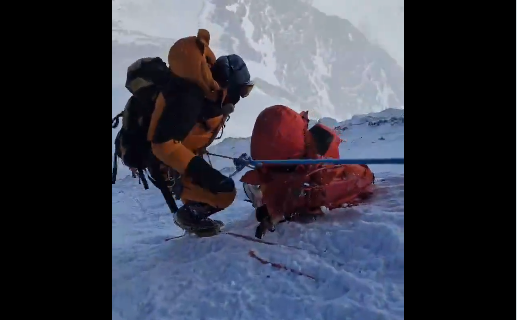The number of bodies left on this mountain grow as more and more see it as the ultimate climb on Earth
Tshiring Jangbu Sherpa cannot erase the memory of the lifeless body he encountered near Mount Lhotse’s peak over a decade ago. In May 2012, while guiding a German climber, he stumbled upon Czech mountaineer Milan Sedlacek’s frozen remains. Intriguingly, Sedlacek’s body was missing a glove, suggesting a tragic slip from the rope led to his demise.
Fast forward 12 years, Sherpa, now 46, returned to Mount Lhotse, not for another ascent, but to retrieve Sedlacek’s body. He was part of a dedicated team comprising military personnel and fellow sherpas, tasked with cleaning the high Himalayas. With over 300 climber deaths recorded in the Everest region and many bodies left behind, the mission was both urgent and symbolic.
🏔️ On Mount #Everest‘s “death zone”, thinning #snow revealed the bodies of hundreds of hopefuls who came to conquer the world’s tallest #mountain but never made it home.
A team is scaling the peak as part of a cleanup campaign to rescue the bodies and pick up #trash ⤵️ pic.twitter.com/ZViQl5ZgM8
— FRANCE 24 English (@France24_en) June 27, 2024
The government first initiated a cleanup campaign in 2019, but this year’s mission was particularly ambitious, aiming to recover five bodies from the perilous “death zone” above 8,000 meters. Although the team managed to retrieve four bodies and 11 tonnes of trash, the operation underscored the dangers and logistical challenges of high-altitude recovery missions.
Major Aditya Karki, the mission leader, highlighted Nepal’s negative image due to the litter and bodies scattered across its majestic peaks. Enhancing safety for climbers was another critical objective, as many had been traumatized by encountering bodies during their treks.
Retrieving bodies from such extreme heights is a daunting task. Financial constraints and the inherent dangers often deter private companies, leaving the military to step in. Each recovery requires a dozen people, copious oxygen supplies, and meticulous planning.
As ice melts, Everest’s ‘death zone’ gives up its ghosts.
Climate change is thinning the snow and ice on Everest, increasingly exposing the bodies of hundreds of mountaineers who died on the world’s highest mountain. This year a team is risking their own lives to bring some of… pic.twitter.com/4DuUqCKFcV
— AFP News Agency (@AFP) June 27, 2024
Sherpa’s team had to navigate the death zone within a narrow 15-day window when the winds are relatively calm. They mostly worked at night to avoid interfering with other climbers. At such altitudes, even the strongest sherpas are severely limited in how much weight they can carry.
The journey to retrieve Sedlacek’s body was grueling. The team faced constant nausea, coughing, and headaches due to the altitude. The body was discolored and partially buried in snow, making the task even more arduous. It took 24 hours to transport the body to the nearest camp and another 13 hours to lower it further.
The bodies were eventually flown to Kathmandu after a weather delay. Identification documents confirmed two of the retrieved bodies as Milan Sedlacek and Ronald Yearwood, an American who died in 2017. The identities of the other two bodies are still being determined.
Unclaimed bodies will be buried after three months, as per Nepali law. This mission holds deep personal significance for Sherpa, who has scaled Everest three times and Lhotse five times since he began climbing at 20. “The Himalayas have given us so much,” he says. “Retrieving these bodies is my way of giving back.”
Major Points
- Tshiring Jangbu Sherpa vividly recalls the sight of a lifeless body near the summit of Mount Lhotse, one of the world’s highest peaks, over a decade ago.
- In May 2012, while guiding a German climber, Sherpa encountered the remains of Czech mountaineer Milan Sedlacek, who had perished days earlier.
- Years later, at 46, Sherpa joined a team of 12 military personnel and 18 sherpas to recover Sedlacek’s body and clean up the high Himalayas.
- Since records began a century ago, the Everest region has seen over 300 deaths, with many bodies still lying where climbers fell.
- Ultimately, the team managed to bring down four bodies and remove 11 tonnes of rubbish over a 54-day operation that ended on June 5.
RM Tomi – Reprinted with permission of Whatfinger News



